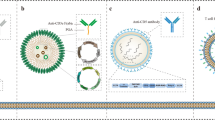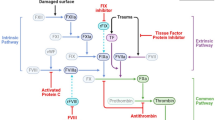Abstract
Gene therapy is the straightforward approach for the application of recent advances in molecular biology into clinical practice. One of the major obstacles in the development of gene therapy is the delivery of the effector to and into the target cell. Unfortunately, most methods commonly used in laboratory practice are poorly suited for clinical use. Viral vectors are one of the most promising methods for gene therapy delivery. Millions of years of evolution of viruses have resulted in the development of various molecular mechanisms for entry into cells, long-term survival within cells, and activation, inhibition, or modification of the host defense mechanisms at all levels. The relatively simple organization of viruses, small genome size, and evolutionary plasticity allow modifying them to create effective instruments for gene therapy approaches. This review summarizes the latest trends in the development of gene therapy, in particular, various aspects and prospects of the development of clinical products based on viral delivery systems.
Similar content being viewed by others
Abbreviations
- AAV:
-
adeno-associated virus
- GT:
-
gene therapy
- HIV:
-
human immunodeficiency virus
- HSC:
-
hematopoietic stem cells
- MLV:
-
murine leukemia virus
- MVA:
-
modified vaccinia virus Ankara
References
Rudchenko, M. N., and Zamyatnin, A. A. (2015) Prospects for using self-assembled nucleic acid structures, Biochemistry (Moscow), 80, 391–399.
Benenson, Y., Gil, B., Ben-Dor, U., Adar, R., and Shapiro, E. (2004) An autonomous molecular computer for logical control of gene expression, Nature, 429, 423–429.
Kahan-Hanum, M., Douek, Y., Adar, R., and Shapiro, E. (2013) A library of programmable DNAzymes that operate in a cellular environment, Sci. Rep., 3, 1535.
Jinek, M., Chylinski, K., Fonfara, I., Hauer, M., Doudna, J. A., and Charpentier, E. (2012) A programmable dualRNA-guided DNA endonuclease in adaptive bacterial immunity, Science, 337, 816–821.
Savitskaya, E. E., Musharova, O. S., and Severinov, K. V. (2016) Diversity of mechanisms of CRISPR-Cas systems of adaptiv immunity of procaryotes and possibilities to use them in biotechnology, Biochemistry (Moscow), 81, 653–661.
Drake, C. G., Lipson, E. J., and Brahmer, J. R. (2014) Breathing new life into immunotherapy: review of melanoma, lung and kidney cancer, Nat. Rev. Clin. Oncol., 11, 24–37.
Mellman, I., Coukos, G., and Dranoff, G. (2011) Cancer immunotherapy comes of age, Nature, 480, 480–489.
Quantin, B., Perricaudet, L. D., Tajbakhsh, S., and Mandel, J. L. (1992) Adenovirus as an expression vector in muscle cells in vivo, Proc. Natl. Acad. Sci. USA, 89, 2581–2584.
Giacca, M. (2010) Gene Therapy, Springer-Verlag, Italy.
Tsai, S. Y., Schillinger, K., and Ye, X. (2000) Adenovirusmediated transfer of regulable gene expression, Curr. Opin. Mol. Ther., 2, 515–523.
Lyons, M., Onion, D., Green, N. K., Aslan, K., Rajaratnam, R., Bazan-Peregrino, M., Phipps, S., Hale, S., Mautner, V., Seymour, L. W., and Fisher, K. D. (2006) Adenovirus type 5 interactions with human blood cells may compromise systemic delivery, Mol. Ther., 14, 118–128.
Hendrickx, R., Stichling, N., Koelen, J., Kuryk, L., Lipiec, A., and Greber, U. F. (2014) Innate immunity to adenovirus, Hum. Gene Ther., 25, 265–284.
Raper, S. E., Chirmule, N., Lee, F. S., Wivel, N. A., Bagg, A., Gao, G. P., Wilson, J. M., and Batshaw, M. L. (2003) Fatal systemic inflammatory response syndrome in a ornithine transcarbamylase deficient patient following adenoviral gene transfer, Mol. Genet. Metab., 80, 148–158.
Nwanegbo, E., Vardas, E., Gao, W., Whittle, H., Sun, H., Rowe, D., Robbins, P. D., and Gambotto, A. (2004) Prevalence of neutralizing antibodies to adenoviral serotypes 5 and 35 in the adult populations of The Gambia, South Africa, and the United States, Clin. Diagn. Lab. Immunol., 11, 351–357.
Roy, S., Clawson, D. S., Lavrukhin, O., Sandhu, A., Miller, J., and Wilson, J. M. (2007) Rescue of chimeric adenoviral vectors to expand the serotype repertoire, J. Virol. Methods, 141, 14–21.
Blaese, R. M., Culver, K. W., Miller, A. D., Carter, C. S., Fleisher, T., Clerici, M., Shearer, G., Chang, L., Chiang, Y., Tolstoshev, P., Greenblatt, J. J., Rosenberg, S. A., Klein, H., Berger, M., Mullen, C. A., Ramsey, W. J., Muul, L., Morgan, R. A., and Anderson, W. F. (1995) T-lymphocytedirected gene therapy for ADA-SCID: initial trial results after 4 years, Science, 270, 475–480.
Bordignon, C., Notarangelo, L. D., Nobili, N., Ferrari, G., Casorati, G., Panina, P., Mazzolari, E., Maggioni, D., Rossi, C., Servida, P., Ugazio, A. G., and Mavilio, F. (1995) Gene therapy in peripheral blood lymphocytes and bone marrow for ADA-immunodeficient patients, Science, 270, 470–475.
Kohn, D. B., Weinberg, K. I., Nolta, J. A., Heiss, L. N., Lenarsky, C., Crooks, G. M., Hanley, M. E., Annett, G., Brooks, J. S., El-Khoureiy, A., Lawrence, K., Wells, D., Moen, R. C., Bastian, J., Williams-Herman, D. E., Elder, M., Wara, D., Bowen, T., Hershfield, M. S., Mullen, C. A., Blaese, R. M., and Parkman, R. (1995) Engraftment of gene-modified umbilical cord blood cells in neonates with adenosine deaminase deficiency, Nat. Med., 1, 1017–1023.
Cattoglio, C., Facchini, G., Sartori, D., Antonelli, A., Miccio, A., Cassani, B., Schmidt, M., Von Kalle, C., Howe, S., Thrasher, A. J., Aiuti, A., Ferrari, G., Recchia, A., and Mavilio, F. (2007) Hot spots of retroviral integration in human CD34+ hematopoietic cells, Blood, 110, 1770–1778.
Cattoglio, C., Pellin, D., Rizzi, E., Maruggi, G., Corti, G., Miselli, F., Sartori, D., Guffanti, A., Di Serio, C., Ambrosi, A., De Bellis, G., and Mavilio, F. (2010) Highdefinition mapping of retroviral integration sites identifies active regulatory elements in human multipotent hematopoietic progenitors, Blood, 116, 5507–5517.
Wu, X., Li, Y., Crise, B., and Burgess, S. M. (2003) Transcription start regions in the human genome are favored targets for MLV integration, Science, 300, 1749–1751.
Hacein-Bey-Abina, S., Garrigue, A., Wang, G. P., Soulier, J., Lim, A., Morillon, E., Clappier, E., Caccavelli, L., Delabesse, E., Beldjord, K., Asnafi, V., Macintyre, E., Dal Cortivo, L., Radford, I., Brousse, N., Sigaux, F., Moshous, D., Hauer, J., Borkhardt, A., Belohradsky, B. H., Wintergerst, U., Velez, M. C., Leiva, L., Sorensen, R., Wulffraat, N., Blanche, S., Bushman, F. D., Fischer, A., and Cavazzana-Calvo, M. (2008) Insertional oncogenesis in 4 patients after retrovirus-mediated gene therapy of SCID-X1, J. Clin. Invest., 118, 3132–3142.
Montini, E., Cesana, D., Schmidt, M., Sanvito, F., Ponzoni, M., Bartholomae, C., Sergi Sergi, L., Benedicenti, F., Ambrosi, A., Di Serio, C., Doglioni, C., Von Kalle, C., and Naldini, L. (2006) Hematopoietic stem cell gene transfer in a tumor-prone mouse model uncovers low genotoxicity of lentiviral vector integration, Nat. Biotechnol., 24, 687–696.
Naldini, L., Blomer, U., Gallay, P., Ory, D., Mulligan, R., Gage, F. H., Verma, I. M., and Trono, D. (1996) In vivo gene delivery and stable transduction of nondividing cells by a lentiviral vector, Science, 272, 263–267.
Poeschla, E., Corbeau, P., and Wong-Staal, F. (1996) Development of HIV vectors for anti-HIV gene therapy, Proc. Natl. Acad. Sci. USA, 93, 11395–11399.
Iwakuma, T., Cui, Y., and Chang, L. J. (1999) Self-inactivating lentiviral vectors with U3 and U5 modifications, Virology, 261, 120–132.
Halbert, C. L., Miller, A. D., McNamara, S., Emerson, J., Gibson, R. L., Ramsey, B., and Aitken, M. L. (2006) Prevalence of neutralizing antibodies against adeno-associated virus (AAV) types 2, 5, and 6 in cystic fibrosis and normal populations: implications for gene therapy using AAV vectors, Hum. Gene Ther., 17, 440–447.
Tse, L. V., Moller-Tank, S., and Asokan, A. (2015) Strategies to circumvent humoral immunity to adenoassociated viral vectors, Expert Opin. Biol. Ther., 15, 845–855.
Rey-Rico, A., and Cucchiarini, M. (2016) Controlled release strategies for rAAV-mediated gene delivery, Acta Biomater., 29, 1–10.
Kotterman, M. A., and Schaffer, D. V. (2014) Engineering adeno-associated viruses for clinical gene therapy, Nat. Rev. Genet., 15, 445–451.
Sanchez-Sampedro, L., Perdiguero, B., Mejias-Perez, E., Garcia-Arriaza, J., Di Pilato, M., and Esteban, M. (2015) The evolution of poxvirus vaccines, Viruses, 7, 1726–1803.
Hata, Y., Etoh, T., Inomata, M., Shiraishi, N., Nishizono, A., and Kitano, S. (2008) Efficacy of oncolytic reovirus against human breast cancer cells, Oncol. Rep., 19, 1395–1398.
Goetz, C., Everson, R. G., Zhang, L. C., and Gromeier, M. (2010) MAPK signal-integrating kinase controls capindependent translation and cell type-specific cytotoxicity of an oncolytic poliovirus, Mol. Ther., 18, 1937–1946.
Borrego-Diaz, E., Mathew, R., Hawkinson, D., Esfandyari, T., Liu, Z., Lee, P. W., and Farassati, F. (2012) Pro-oncogenic cell signaling machinery as a target for oncolytic viruses, Curr. Pharm. Biotechnol., 13, 1742–1749.
Esfandyari, T., Tefferi, A., Szmidt, A., Alain, T., Zwolak, P., Lasho, T., Lee, P. W., and Farassati, F. (2009) Transcription factors down-stream of Ras as molecular indicators for targeting malignancies with oncolytic herpes virus, Mol. Oncol., 3, 464–468.
Kantor, B., Bailey, R. M., Wimberly, K., Kalburgi, S. N., and Gray, S. J. (2014) Methods for gene transfer to the central nervous system, Adv. Genet., 87, 125–197.
Alsaggar, M., and Liu, D. (2015) Physical methods for gene transfer, Adv. Genet., 89, 1–24.
Sergeeva, O. V., Koteliansky, V. E., and Zatsepin, T. S. (2016) Using mRNAs for therapy–achivements and perspectives, Biochemistry (Moscow), 81, 709–722.
Li, B., Luo, X., and Dong, Y. (2016) Effects of chemically modified messenger RNA on protein expression, Bioconj. Chem., 27, 849–853.
Wade, N. (1981) Gene therapy caught in more entanglements, Science, 212, 24–25.
Marshall, E. (1999) Gene therapy death prompts review of adenovirus vector, Science, 286, 2244–2245.
Yu, W., and Fang, H. (2007) Clinical trials with oncolytic adenovirus in China, Curr. Cancer Drug Targets, 7, 141–148.
Mironov, A. N., Vasiliev, A. N., Goryachev, D. V., Gavrishina, E. V., and Niyasov, R. R. (2014) Medicines for advanced therapies: scientific approaches to validate quality, safety and efficacy, Remedium, Nos. 7-8, 16–24.
Galli, M. C., and Serabian, M. (2014) Regulatory aspects of gene therapy and cell therapy products: a global perspective, Adv. Exp. Med. Biol., 871, 1–221.
Villemejane, J., and Mir, L. M. (2009) Physical methods of nucleic acid transfer: general concepts and applications, Br. J. Pharmacol., 157, 207–219.
Author information
Authors and Affiliations
Corresponding author
Additional information
Original Russian Text © A. N. Lukashev, A. A. Zamyatnin, Jr., 2016, published in Biokhimiya, 2016, Vol. 81, No. 7, pp. 926-936.
To whom correspondence should be addressed.
Rights and permissions
About this article
Cite this article
Lukashev, A.N., Zamyatnin, A.A. Viral vectors for gene therapy: Current state and clinical perspectives. Biochemistry Moscow 81, 700–708 (2016). https://doi.org/10.1134/S0006297916070063
Received:
Published:
Issue Date:
DOI: https://doi.org/10.1134/S0006297916070063




